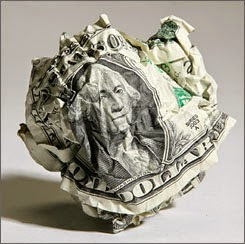
The US dollar has yet to stabilize against the euro and sterling, although it has steadied against the dollar-bloc currencies and yen. The euro has been bid through the $1.10 level on the back of stronger month supply growth and the first positive growth in private credit in two years. After finishing yesterday’s North American session on its highs, fully recovering from the disappointing Q1 GDP, sterling has extended its gains to $1.54. Since the April 13 low near $1.4565, sterling has appreciated by 5.8% or nearly 8.5 cents.Â
We suspect the market is getting ahead of itself. A FOMC statement today that keeps the June meeting live could help the greenback, but that alone may not be convincing. Instead, it may take a robust jobs report at the end of next week put a more solid floor under the dollar. Â
The FOMC statement will recognize the weakness of the economy, and indeed there may be some downside risks to the consensus estimate of 1% Q1 GDP that will be reported today ahead of the Fed meeting. Fed officials have already said as much in their speeches. However, they recognize that the main headwinds are likely to prove transitory. There is no reason at this juncture to reconsider this.  Â
The trajectory of monetary policy is not a hostage to Q1 data. We do not expect the Fed to rule out a June hike. It has worked hard to shift the focus from dates to data. Ruling out a June hike is contrary to this thrust.Â
Ahead of the US Q1 GDP report and the FOMC meeting there have been five developments to note. First, euro area money supply growth continued to accelerate in March. The 4.6% year-over-year pace (4.0% in February) is the strongest in six years. Moreover, private credit growth turned positive (0.1% from flat) which is the first such reading since 2012. This would seem to show improving financial conditions. Yet with the ECB’s asset purchases program still in its early days and the distortions caused by negative interest rates still rippling through, it is difficult to separate the shift in portfolio preferences from the true underlying improvement. Â

